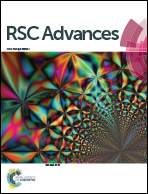Bi2O3 and BiOCl electrospun nanosheets and morphology-dependent photocatalytic properties†
Abstract
BiOCl and Bi2O3 nanosheet like structures were produced by electrospinning. The morphological changes were observed by changing precursor (BiOCl3 and Bi(NO3)3·5H2O) concentrations. These nanosheets were analyzed by XRD, which reveals that the crystal structures of BiOCl and Bi2O3 belonged to tetragonal and beta-phase systems respectively. Both nanostructures were employed for the photodegradation of Alizarin Red S (ARS) dye under UV light (<390 nm) irradiation. BiOCl nanosheet like structures exhibited superior photocatalytic activity (PCA) for the degradation of ARS dye and their half-life was estimated from the kinetic plots of PCA. A plausible reaction mechanism is proposed for the PCA and discussed in detail.


 Please wait while we load your content...
Please wait while we load your content...